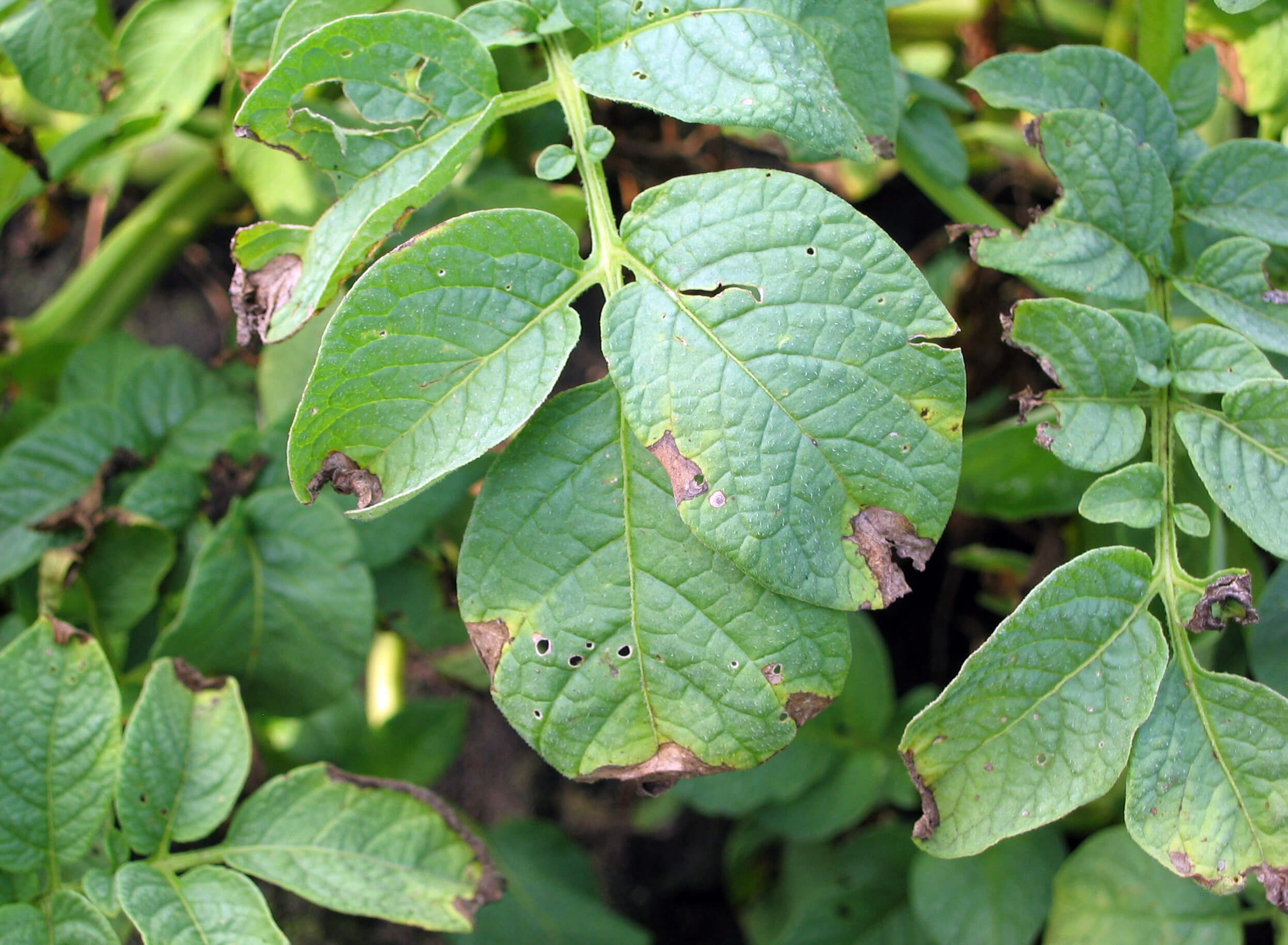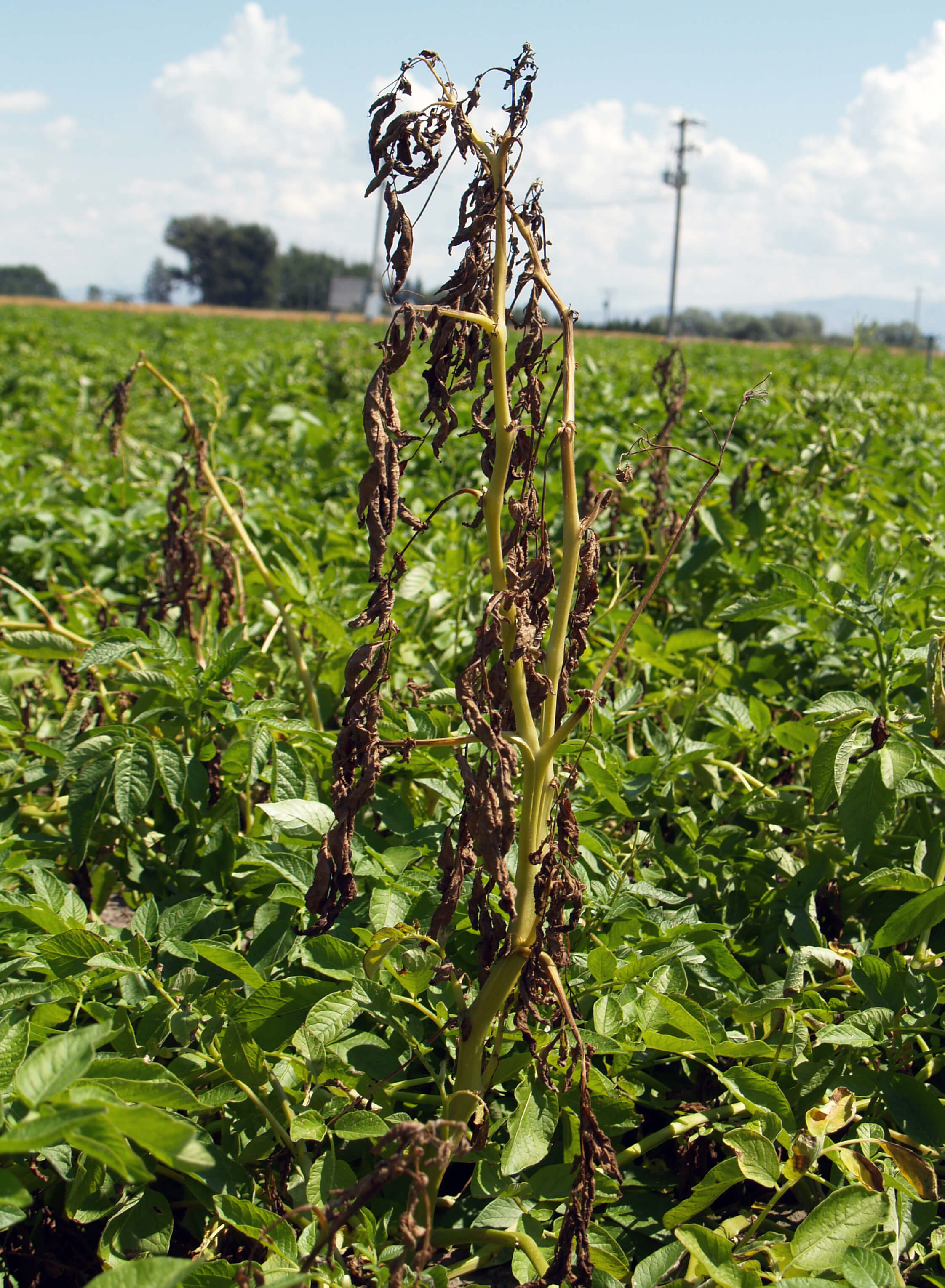This article appears in the July 2017 issue of Potato Grower.
It appears that every year potato growers in Idaho are faced with some kind of regional or statewide disease problem. In the past few years, late blight has been the hot topic on everyone’s lips with the limited outbreak in 2014 and the widespread regional outbreak in southeastern Idaho in 2015. Fortunately, the predicted late blight outbreak for 2016 did not materialize, as the weather turned hot and dry in June and stayed that way through August, creating conditions unsuitable for late blight. However, one disease that was widespread in 2016 but got little press coverage was gray mold. This was probably due to the fact that gray mold foliar lesions are often confused with other foliar diseases such as early blight. In the latter stages of heavy infection, symptoms are often confused with Verticillium wilt.
Gray mold is caused by the fungus Botrytis cinerea and is found wherever potatoes are grown in Idaho. The pathogen has a wide host range, causing disease on more than 200 different hosts. The disease is favored by very moist conditions and is especially common in fields with overhead irrigation such as a center pivot. It is usually considered an opportunistic pathogen of minor significance and is often first found in the lower, older, senescing leaves. Heavy infection will eventually lead to the early death of the plant, which results in lower yields and tuber quality.
 Foliar lesions develop during periods of cool, wet weather, occur at the tips of leaves, and are wedge-shaped. Lesions may be confused with those of early and late blight; they are often bounded by major veins and a chlorotic band of tissue. On senescent leaves, lesions may be water-soaked and develop a slimy rot. Infection and colonization of leaves often lead to infection of petioles, which constricts the vascular system leading to the death of the whole leaf petiole. Heavy infection can lead to upright stems covered in dead leaves and petioles. These symptoms can be very similar to those of Verticillium wilt. When lesions occur under a dense crop canopy where humidity is high, a grayish-black or brown mold is often visible on infected stems and leaves. Although extremely rare, at harvest a dry rot-like tuber infection can occur in storage. The tuber surface becomes wrinkled and underlying tissue becomes soft, developing a watery, brown decay.
Foliar lesions develop during periods of cool, wet weather, occur at the tips of leaves, and are wedge-shaped. Lesions may be confused with those of early and late blight; they are often bounded by major veins and a chlorotic band of tissue. On senescent leaves, lesions may be water-soaked and develop a slimy rot. Infection and colonization of leaves often lead to infection of petioles, which constricts the vascular system leading to the death of the whole leaf petiole. Heavy infection can lead to upright stems covered in dead leaves and petioles. These symptoms can be very similar to those of Verticillium wilt. When lesions occur under a dense crop canopy where humidity is high, a grayish-black or brown mold is often visible on infected stems and leaves. Although extremely rare, at harvest a dry rot-like tuber infection can occur in storage. The tuber surface becomes wrinkled and underlying tissue becomes soft, developing a watery, brown decay.
The gray mold pathogen overwinters on crop debris, and pathogen spores are disseminated by wind, rain splash and irrigation. Infection requires high humidity and cool temperatures, which start to occur more frequently as rows start to close. The spores of this pathogen are ubiquitous, as it is has a host range of over 200 other crops, many of which are grown in rotation with potato in Idaho. Spores collect in pooling drops of water in depressions on flowers, leaves and  stems. In potato, infections often become established in flowers in midseason and later in senescing lower leaves, which become stressed as a result of shading or excessive humidity.
stems. In potato, infections often become established in flowers in midseason and later in senescing lower leaves, which become stressed as a result of shading or excessive humidity.
Effective management of gray mold requires an integrated disease management strategy similar to those used to control early blight and white mold. This disease is primarily controlled by the use of foliar fungicides. Most of the fungicides registered for use on potato in Idaho are protective against gray mold and are effective in preventing infection and disease development. However, they will not control disease once it has become established.
Recent fungicide trials carried out at the University of Idaho’s Aberdeen Research & Extension Center have shown that the most effective timings for control of gray mold is to make the first fungicide application at least seven to 14 days prior to row closure, and then on a 14-day schedule after that. Fungicides containing pyrimethanil, such as Scala and Luna Tranquility, were found to be most effective in controlling gray mold.